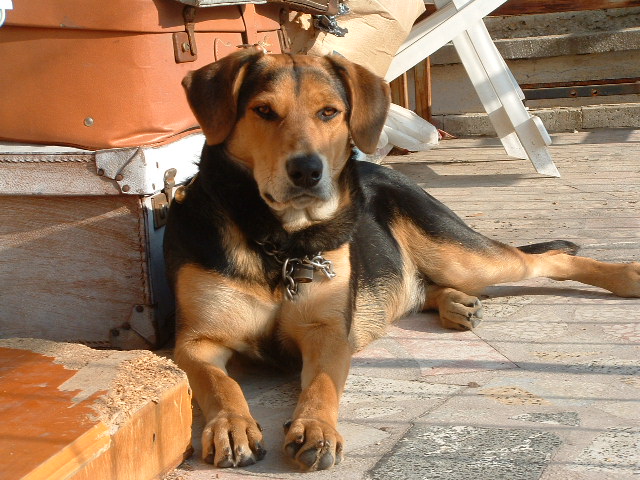|
.
ASABi; (baba) - (anne)
Breed; Hellenic Hound, Greek Harehound, Hellenikos Ichnilatis, Greek Hound
.
12 Aralık 2006 Salı, 15:03:48.
8 Aylikken
Hellenic Hound
Breed Organization
The American Canine Association, Inc. (ACA)
800 Delaware Avenue
Reg. Dept, Box 992
Wilmington, DE 19899-0992
Phone: 1-800-651-8332
Website: www.acavet.com
Native Country
Greece Other Names
Greek Harehound, Hellenikos Ichnilatis,
Greek Hound Breed Description about this breedHead: Long. Flat skull. Stop not very pronounced. Straight or slightly curved nosebridge. Strong jaws. Fairly
developed lips. Ears: Medium-sized, set on high, flat, rounded at the tip, pendulous. Eyes: Normal
in size, brown. Body: Slightly longer than it is tall. Mesomorph. Neck powerful, muscular, without dewlap.
Well-developed chest. Slightly circular ribs. Slightly arched, short, strong, well-muscled loin. Slight tuck-up. Long, straight
back. Croup long, broad, nearly level. Tail: Short, thick at the base and tapering slightly toward the tip.
In action, carried in saber fashion. Hair: Close-lying, dense, somewhat hard. Coat: Black and
tan. A small white spot on the chest is tolerated. Visible mucosa, nose, and nails are black. Size: Dog: 47
to 55 cm. (18.5-21.5 in).Bitch: 45 to 53 cm. (17.5-21 in). Weight: 17 to 20 kg (37-44 lb). History
This very ancient breed indigenous
to Greece is believed to be descended from hounds brought from Egypt by the Phoenicians. The Hellenic Hound is not very well-known
outside his native land. Behavior
Very
hardy, vigorous, and lively, the Hellenic Hound has a subtle nose and a far-reaching, melodic voice. Skilled in hunting on
rugged terrain, he is a speedy and light-footed tracker of all game alone or in small packs. He is not well-suited to being
a pet. He needs firm training. Advice
He
needs space and a lot of exercise. Regular brushing. Function
Hunting
dog.
| Some of the reference material was provided by: |
| |
 |
 |
 |
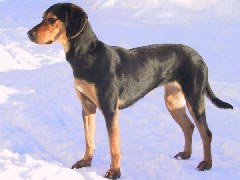
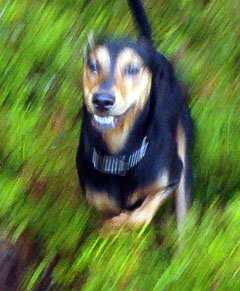
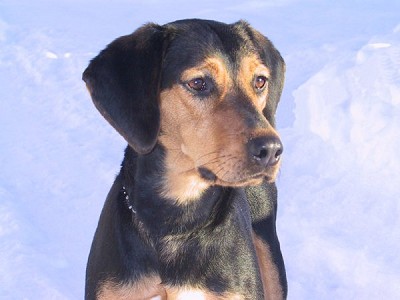
Hellenikos Ichnilatisz Pictures
(Hellenic Hound) (Greek
Harehound) (Greek Hound)
|
Pronunciation |
- |
|
Description |
TheHellenikos Ichnilatis is Of medium size and shaped by function rather than fashion, the breed is a prototype hunter that uses its fine nose
and high average speed to track and catch its prey. There are no extremes in its conformation: athletic, robust and of normal
proportions, the Hellenikos Ichnilatis is slightly longer than tall, with taught skin and short, sleek hair. Predominately
black with tan markings (there are no specific limitations as to the tan markings, apart from the fact that the color should
be rich and discoloration is a very serious type fault); a small white spot is tolerated on the chest. The head is noble and
houndy but never coarse nor as heavy as a bloodhound’s. The ears should lie flat and be neither too long nor too heavy.
The nose and nails are black and the pigment should be dark and strong. The breed has a regular scissor bite and the eye-rims
should be tight, showing no haw. |
|
Temperament |
Brave, outgoing, intelligent
and sometimes impatient, they are passionate hunters but they never vicious. Friendly, affectionate and extremely playful.
As a farm dog it’s happy and useful in many ways, as it is not without a sense of boundaries and it will give voice
in the presence of strangers or danger, relentlessly chasing vermin as well. Extremely courageous and resourceful, it possesses
the stamina and cunning necessary to face the wild boar. However, in the presence of its master, it’s a happy and friendly
fellow, wagging its tail and living peacefully with other dogs. Traditionally, the breed hunts in pairs or small groups of
three or four dogs. They are surprisingly swift and powerful for their size. While essentially good-natured, this is an independent
breed; young males are best raised by an experienced handler. Maturity comes late, usually at two or three years of age. The
Hellenikos Ichnilatis has a beautiful and loud voice that can be heard for many miles. The breed gives voice on the chase
and is fit to travel great distances on the gallop, capable to hunt independently if it has to, before turning the hare towards
its handler. This innate ability means that the breed has a strong temperament and they can be stubborn at youth and slow
maturing. Rough handling makes them worse as does lack of proper discipline; they need careful guidance, patience and understanding. |
|
Height, Weight |
Weight: 38-44 pounds (17-20 kg.)
Height: 18-22 inches (45-55 cm.) |
|
Health Problems |
This breed has an excellent health record. |
|
Living Conditions |
This is a natural breed that loves open spaces and can be a
handful for the inexperienced dog owner. Certainly not a choice for the apartment dweller, this is an open-air breed that
shows excellent manners when its needs are catered for. |
|
Exercise |
TheHellenikos Ichnilatis require a certain amount of
freedom and plenty of exercise. This breed thrives on exercise, and if restricted tends to be destructive. They need to be taken on a daily walk. |
|
Life Expectancy |
About 11 years. |
|
Grooming |
The smooth, short-haired coat is easy to keep in peak condition. Brush with a
firm bristle brush, and dry shampoo occasionally. Bathe in mild soap only when necessary. Inspect the feet and mouth for damage
after work or exercise sessions. Keep the nails trimmed. This breed is an average shedder. |
|
Origin |
The Hellenikos Ichnilatis is a black and tan
tracking & chasing hare hound, indigenous to Greece. It
exists for thousands of years and its progenitors are the ancient laconikoi (later: lagonikoi, where lagos=hare) kynes (dogs)
native in the Southern Greece (Peloponessus). These were described and praised by many ancient writers and through colonization
and sea-trade they became widespread in the ancient world. Descendants of the ancient Greek scenthounds can be found all over
Europe and beyond. In its country of origin the breed had no competition and due to its isolation in inaccessible & often
mountainous areas the breed remained pure and little changed. Ancient Greece covered most of the Balkans and so the Hellenikos
Ichnilatis left its heritage in the neighboring countries, too: black and tan or tricolor scenthounds can be found all over
this area. In Greece too, there is a not-yet officially recognized tricolor variety, localized in the very same vicinity that
the ancient breed took its first name, in Laconia (Sparta), a south-most part of Peloponessus. In 1996 the Hellenikos Ichnilatis
became the first Greek breed recognized by the FCI. |
|
Group |
Hound |
|
Recognition |
FCI, APRI, ACR |
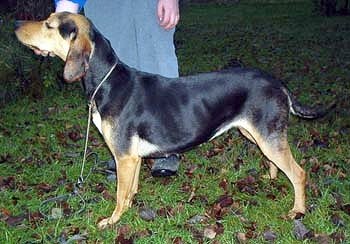
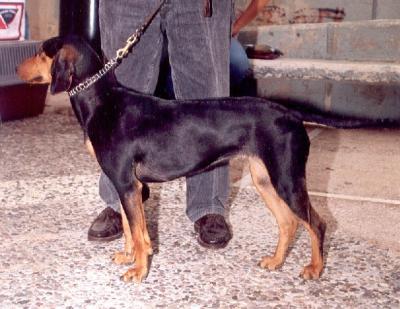
HELLENIKOS ICHNILATIS
(Greek Harehound or scenthound)
History & Origin
The Hellenikos Ichnilatis is a black and tan tracking & chasing hare hound,
indigenous to Greece.
It exists for thousands of years and its progenitors are the ancient laconikoi (later:
lagonikoi, where lagos=hare) kynes (dogs) native in the Southern Greece
(Peloponessus). These were described and praised by many ancient writers and through
colonization and sea-trade they became widespread in the ancient world.
**** ****
Descendants of the ancient Greek scenthounds can be found all over Europe
and beyond. In its country of origin the breed had no competition and due to its isolation in
inaccessible & often mountainous areas the breed remained pure and little changed.
Ancient Greece covered most of the Balkans and so the Hellenikos Ichnilatis left its
heritage in the neighboring countries, too: black and tan or tricolor scenthounds can be
found all over this area. In Greece too, there is a not-yet officially recognized tricolor variety,
localized in the very same vicinity that the ancient breed took its first name, in Laconia
(Sparta), a south-most part of Peloponessus.
Form, Function, Requirements
Of medium size and shaped by function rather than fashion, the breed is a prototype
hunter that uses its fine nose and high average speed to track and catch its prey.
There are no extremes in its conformation: athletic, robust and of
normal proportions, the Hellenikos Ichnilatis is slightly longer than tall, with
taught skin and short, sleek hair.
Predominately black with tan markings (there are no specific limitations as to the tan markings,
apart from the fact that the color should be rich and discoloration is a very serious type fault);
a small white spot is tolerated on the chest. The head is noble and houndy but never coarse nor as
heavy as a bloodhound's. The ears should lie flat and be neither too long nor too heavy.
The nose and nails are black and the pigment should be dark and strong. The breed has a
regular scissor bite and the eye-rims should be tight, showing no haw. The Hellenikos
Ichnilatis has a beautiful and loud voice that can be heard for many miles.The breed gives
voice on the chase and is fit to travel great distances on the gallop, capable to hunt
independedly if it has to, before turning the hare towards its handler. This innate ability
means that the breed has a strong temperament and they can be stubborn at
youth and slow maturing. Rough handling makes them worse as does lack of proper
discipline; they need careful guidance, patience and understanding. Also they
require a certain amount of freedom and plenty of exercise.
Character
Brave, outgoing, intelligent and sometimes impatient, they are passionate
hunters but they never vicious. Friendly, affectionate and extremely playful, this is a
natural breed that loves open spaces and can be a handful for the inexperienced dog
owner. Certainly not a choice for the apartment dweller, this is an open-air breed
that shows excellent manners when its needs are catered for. As a farm dog it’s happy and
useful in many ways, as it is not without a sense of boundaries and it will give voice in
the presence of strangers or danger, relentlessly chasing vermin as well. Extremely
courageous and resourceful, it possesses the stamina and cunning necessary to face the
wild boar. However, in the presence of its master, it's a happy and friendly fellow,
wagging its tail and living peacefully with other dogs. Traditionally, the breed hunts in
pairs or small groups of three or four dogs.
Information & Contacts
The height is 47-55cm at the withers for dogs, 2cm less for bitches; the animals should
be athletic, in good condition, neither fat nor too thin.A copy of the official breed standard
(FCI no 214) in english and information about breeders, puppies etc can be obtained by the
parent club: Friends of the Hellenikos Ichnilatis
(Text: Maria Winsor-Ginala, foundermember of the Hellenikos Ichnilatis Club, Greece.)
|

